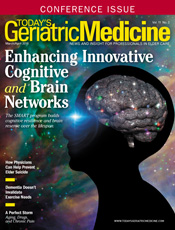
March/April 2018
Innovations in Geriatrics: Treating Spasticity Following Stroke Stroke is the leading cause of serious long-term disability in the United States.1 Several complications can result from a stroke, including spasticity, a condition in which an individual experiences an abnormal increase in muscle tone or stiffness.1 Although spasticity is associated with brain or spine injury and a number of neurological disorders such as adult cerebral palsy and multiple sclerosis, stroke survivors are among the most prominent groups to be impacted by the condition. In fact, it is estimated that approximately one million adult stroke survivors in the United States are living with some form of spasticity.2 Understanding Spasticity Poststroke patients can experience various combinations of ULS and LLS, depending on the patient. Among stroke survivors after 12 months, the estimated prevalence of spasticity occurrence in any limb is 17%. Ten percent of stroke survivors experience spasticity in both the upper and lower limbs.6 More Than a Spasm It is important for patients to talk to their health care providers about symptoms they are experiencing after a stroke, as spasticity can be overlooked. In some cases, patients or the family believe there is nothing that can be done to remedy this occurrence.7 Treating Spasticity Treatment for spasticity may include an injection of botulinum toxin to help reduce muscle stiffness and tightness.8 BOTOX (onabotulinumtoxinA), a prescription injectable therapy, was approved by the FDA for the treatment of increased stiffness in the elbow, wrist, and finger muscles in adults with ULS in March 2010.9 The FDA approved an expansion of the BOTOX label for the treatment of adults with ULS in April 2015, and in January 2016, it approved BOTOX to treat increased stiffness in ankle and toe muscles in adults with LLS.9 In adult patients diagnosed with ULS or LLS, BOTOX is injected directly into the affected muscles by a trained medical specialist, such as a neurologist or physiatrist, using a fine needle. It works by blocking signals from nerves to muscles, reducing the contractions caused by spasticity.10 BOTOX has not been shown to help people perform task-specific functions with upper limbs or increase movement in joints that are permanently fixed in position by stiff muscles, and it is not meant to replace existing physical therapy or other rehabilitation that may have been prescribed.9 Patients can also be treated with oral medications to reduce the tone in the muscles. Additionally, physical therapy regimens such as muscle stretching and range-of-motion exercises can help prevent shortening of muscles.8 Barriers to Care It is critical that patients who experience symptoms of spasticity continue to seek treatment from a health care provider with a specialty in managing spasticity to help manage the impact of poststroke symptoms in addition to preventing another stroke. To learn more about spasticity and to find a specialist, visit www.botoxspasticity.com. — Atul T. Patel, MD, MHSA, is a physical medicine and rehabilitation physician at Kansas City Bone & Joint. He is board certified in physical medicine and rehabilitation, spinal cord medicine, neuromuscular medicine, brain injury medicine, and electrodiagnostic medicine. His clinical areas of interest include musculoskeletal medicine, neuropathic pain, spasticity, movement disorders such as Parkinson's disease and dystonias, stroke rehabilitation, multiple sclerosis, nerve and muscle diseases, geriatrics, electrodiagnostic medicine, and general rehabilitation medicine. References 2. Data on File, Allergan, Inc. Global safety and epidemiology: spasticity and comorbidity following five disorders: stroke, multiple sclerosis, spinal cord injury, traumatic brain injury, and cerebral palsy in adults, 2009. 3. Mayer NH, Esquenazi A. Muscle overactivity and movement dysfunction in the upper motoneuron syndrome. Phys Med Rehabil Clin N Am. 2003;14(4):855-883. 4. Esquenazi A. Falls and fractures in older post-stroke patients with spasticity: consequences and drug treatment considerations. Clin Geriatr. 2004;12(8):27-35. 5. Spasticity. American Association of Neurological Surgeons website. http://www.aans.org/en/Patient%20Information/Conditions%20and%20Treatments/Spasticity.aspx. Accessed January 10, 2017. 6. Wissel J, Schelosky LD, Scott J, Christe W, Faiss JH, Mueller J. Early development of spasticity following stroke: a prospective, observational trial. J Neurol. 2010;257(7):1067-1072. 7. Allergan. New survey highlights impact of common, but under-recognized condition on stroke survivors and their caregivers. PR Newswire website. http://www.prnewswire.com/news-releases/new-survey-highlights-impact-of-common1-but-under-recognized-condition-on-stroke-survivors-and-their-caregivers-229688041.html. Published October 29, 2013. Accessed September 28, 2017. 8. Mostoufi SA. Spasticity and its management. Pain Manag Rounds. 2005;2(5):1-6. 9. Allergan. U.S. FDA approves BOTOX (onabotulinumtoxinA) for the treatment of lower limb spasticity in adults. PR Newswire website. https://www.prnewswire.com/news-releases/us-fda-approves-botox-onabotulinumtoxina-for-the-treatment-of-lower-limb-spasticity-in-adults-300208358.html. Published January 22, 2016. 10. Allergan. Highlights of prescribing information: BOTOX (onabotulinumtoxinA) for injection, for intramuscular, intradetrusor, or intradermal use. https://www.allergan.com/assets/pdf/botox_pi.pdf |
